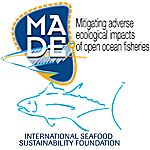We analyzed spatio-temporal distribution patterns of large pelagic fishes in interaction with the pelagic longline gear. Data were collected during scientific surveys carried out in the Central South Pacific (French Polynesia) by using an instrumented longline (ILL) equipped with both hook timers and time depth recorders (TDR). A total of ~ 160 ILL survey operations targeting tuna species (Thunnus alalunga, T. albacares and T. obesus) were performed. Data downloaded from TDR attached to the expected deepest point of the mainline basket confirmed that the major part of the vertical habitat of large pelagic fishes was prospected. Each hooking contact was characterized by four variables: horizontal position along the mainline, hooking depth, time and the species caught for hooking successes. Results of our data analysis based on spatial point process displayed clear spatial and temporal patches of both hooking contacts and captures. They revealed locally clustered interactions between the large pelagic fish and the gear. We examined the relation between the catch composition (target species versus bycatch) and the structure of identified clusters. We discuss possible implications of these spatio temporal patterns of catches in pelagic longline ecosystem-based fisheries management and bycatch mitigation measures.
- Presentation

 PDF version
PDF version
